There was no formal agenda on Feb. 12, 2018, when Bruce King and William Kelley met for lunch at the Lotus Cafe in San Rafael, Calif. But building regulation is a favorite topic of King’s, a structural engineer devoted to reducing carbon emissions related to buildings. So it was no surprise to Kelley, Marin County’s deputy director for building and safety, that King suggested it would “be nice” to craft a low-carbon concrete building code “to rein in the profligate overuse” of carbon-intensive cement in concrete.
Kelley liked the idea of regulating concrete’s embodied carbon (EC)—the greenhouse gases (GHGs) emitted during production. But funding was needed to support the writing of a code for low-EC concrete.
Two weeks later, King happened to be at a meeting of an ad hoc group trying to rebuild sustainably after California’s devastating 2017 wine-country fires. There, he heard an announcement that the Bay Area Air Quality Management District would soon offer grants for novel methods of addressing GHGs. He alerted Kelley. Soon, Marin County applied for a BAAQMD grant, which it received on Oct. 4, 2018.
The funds, a maximum of $206,456, set the wheels in motion for developing the model Bay Area Low-Carbon Concrete Code. If approved by Marin County’s board of supervisors on Nov. 19, the code, unprecedented in the U.S. because it would limit EC in private—not just public—projects, would be the first of its kind in the nation.
Kelley likes the Bay Area model code because it is simple to use for customers, plan checkers and enforcers. The document, only four pages long, has two sets of compliance pathways for plain and reinforced concrete: 1) limit cement in either the mix or the project; or 2) limit the global warming potential (GWP) either of a concrete mix—based on an approved environmental product declaration (EPD)—or a project, taking into account all the mix designs.
If adopted, the code would apply only to unincorporated Marin County, population 60,000. That doesn’t bother King. “We hope it will be the code heard around the world,” says the founder of the 20-year-old Ecological Building Network (EBNet).
Graphic Courtesy World GBC
Kelley agrees, saying, “If we can do this here, the code could serve as a template for other places.” Several other Bay Area counties are likely to follow suit if Marin County adopts it, he adds.
King is setting even wider sights on the regulation of EC—the GHG emissions associated with raw material supply, manufacturing, transport, construction, maintenance, decommissioning and recycling of a material, a building or infrastructure. He wants the Bay Area code to serve as a model for other nations, especially India and China. He also wants EC codes for other high-EC products, such as most refrigerants.
EC, formerly called embodied energy, is not exactly a household term in construction. The main focus in green building codes and certification programs—such as LEED and the Living Building Challenge—has been on reducing the operational carbon (OC) emitted by buildings.
EC plus OC make up the carbon footprint of a building. Initial or up-front EC, which accounts for most of a material’s or a product’s carbon, refers to GHG emissions from the cradle to the site gate.
“Many construction materials can be made to very similar performance standards with 50% or more carbon savings,” because manufacturing process, mix composition, recycled content and electricity or energy source have a dramatic effect on carbon emitted during manufacture, according to the University of Washington’s Carbon Leadership Forum. CLF is a nonprofit coalition of 40 construction industry sponsors, founded in 2009 by its director, Kate Simonen, also a professor at the College of the Built Environments.
Carbon-aware specification and procurement policies, backed by a contractual requirement to deliver verified environmental product declarations (EPDs) for materials delivered to sites, "can drive change,” asserts CLF.
Reducing initial EC is no easy task. It has been fraught with problems—from a lack of product and material data to data too complex to evaluate. “It’s an incredibly daunting and new challenge to address in a design process,” says Victoria Burrows, director of Advancing Net Zero for the World Green Building Council.
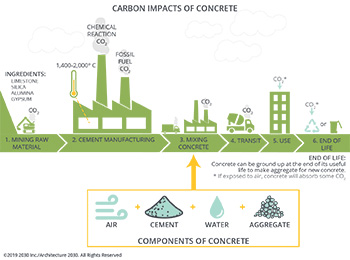 A net-zero EC building is one that has minimal up-front carbon, with all remaining EC offset so that emissions over the life cycle of the building are effectively eliminated. The group’s ambitious goal is to mobilize the global construction industry to get to net-zero EC in all new construction and renovations by 2050 (ENR 10/7 p. 6).
A net-zero EC building is one that has minimal up-front carbon, with all remaining EC offset so that emissions over the life cycle of the building are effectively eliminated. The group’s ambitious goal is to mobilize the global construction industry to get to net-zero EC in all new construction and renovations by 2050 (ENR 10/7 p. 6).
Don Davies, president of structural engineer Magnusson Klemencic Associates (MKA), a CLF sponsor, says widespread EC reduction in buildings is “still the promise.”
Davies and other climate activists say awareness-raising and re-education are needed to turn EC reduction into a reality. This includes owners and developers, building teams and manufacturers and their suppliers.
“We, as consumers of building products, have an ethical responsibility to minimize the negative impacts of buildings all the way up the supply chain,” says Stacy Smedley, a director of sustainability with Skanska USA—also a CLF sponsor.
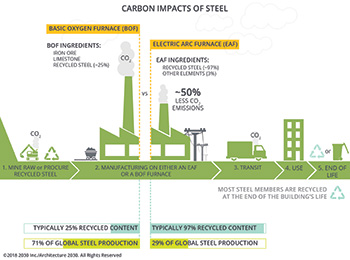 Momentum is beginning to build around EC diets, in part spurred by regulation. One example is the 2017 Buy Clean California Act, which requires state agencies to consider the EC of industrial products when contracting for state-funded infrastructure projects.
Momentum is beginning to build around EC diets, in part spurred by regulation. One example is the 2017 Buy Clean California Act, which requires state agencies to consider the EC of industrial products when contracting for state-funded infrastructure projects.
The state has the buying power to leverage change. It spends more than $10 billion annually on bridges, roads, facilities and other infrastructure.
Buy Clean requires contractors bidding on projects to disclose the GHG data for structural steel, steel reinforcing bars, flat glass and mineral wool board insulation. These materials must have a global warming potential (GWP) that does not exceed limits set by the state.
Berkeley, Richmond, Cupertino, Santa Cruz County and Los Angeles have adopted resolutions in support of the act.
Buy Clean does not list cement or concrete, but those and other materials can be added in the future. Still, concrete EC regs are coming. For starters, Portland, Ore., has a new ordinance for phasing in more-sustainable concrete in city projects that contain over 50,000 cu yd. And New York State Assembly member Robert Carroll (D) recently introduced a low-EC concrete procurement bill for state projects.
 Concrete is often viewed as the low-hanging fruit for EC regulation, in part because cement is responsible for 90% of concrete’s negative environmental impact—one ton represents about one ton of GHGs—and because there are lower-carbon substitutes for cement, such as fly ash or slag. “It’s easier to adjust a mix than to retool a steel mill,” says one EC expert.
Concrete is often viewed as the low-hanging fruit for EC regulation, in part because cement is responsible for 90% of concrete’s negative environmental impact—one ton represents about one ton of GHGs—and because there are lower-carbon substitutes for cement, such as fly ash or slag. “It’s easier to adjust a mix than to retool a steel mill,” says one EC expert.
To reduce initial EC, it is necessary for building teams to track and measure emissions in the entire building supply chain. The process relies on the manufacturer’s creation of a life-cycle assessment for each product or a plant LCA—or both. An LCA, which can cost $10,000 to $15,000, is a technique to analyze environmental impacts associated with all the stages of a product’s or a building’s life—even recycling.
An environmental product declaration, which is built from at least a partial LCA, is also necessary. An EPD provides quantified environmental data for a product, including GWP from GHGs. GWP is listed in kilograms of CO2-equivalent (kg CO2eq).
In theory, LCAs and EPDs, prepared by consultants, help designers write low-carbon specifications to ensure contractors get bids from suppliers of low-EC materials and products.
Tough To Compare
Building teams have issues with LCAs and EPDs. LCAs are not standardized, which makes LCAs and EPDs prepared by different consultants tough to compare. In addition, the shorter EPDs, which still average 12 to 15 pages, are not available for all materials. And EPDs for like materials are often based on industry averages, which makes it difficult to compare the same material from different suppliers.
Much of that is about to change for the better on Nov. 19—by coincidence the same day as the scheduled Marin County action on the low-carbon concrete code. In Atlanta, at the Greenbuild International Conference and Expo, CLF is launching the first-of-its-kind cloud-hosted tool—open source and free of charge—to help building teams make better-informed choices about EC reduction.
The tool is called the Embodied Carbon in Construction Calculator. “We are growing a movement of embodied carbon champions,” says Simonen. “EC3 is one key part.”
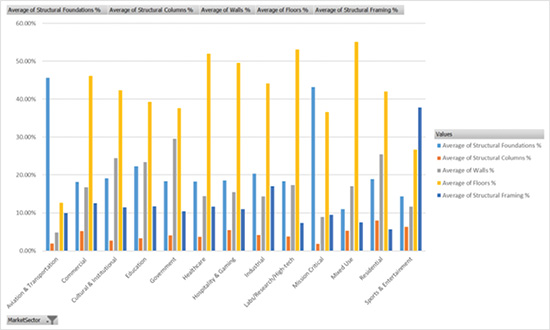
First of its kind study of EC in structural elements in 600 developments shows that a structure’s floor diaphragms have the highest carbon content in most building types. Graphic Courtesy Thornton Tomasetti
A public searchable database, the tool is based on data from nearly 20,000 EPDs for more than 15 types of materials/products. Some of the categories are concrete, steel, flooring, aggregates, ceiling panels, wood, gypsum board and insulation.
The tool will make it much simpler to compare EC in like materials, for example steel from different mills or concrete from different suppliers. “We’re creating an ecosystem that allows value to be recognized for low-carbon material suppliers in each material type and we are helping owners make more informed decisions,” says MKA’s Davies, who is involved with EC3.
Users can analyze the EC in a material in 10 to 15 seconds. It takes 15 to 30 minutes to analyze a project. “We are leveraging quite modern information technology that can handle huge amounts of data at low cost,” says Phil Northcott, CEO of C Change Labs, EC3’s software developer.
In addition, the tool can be used to create more-credible EC project budgets and to consistently track EC targets during construction, says CLF.
“EC3 is going to be a big help for companies,” says William Paddock, managing director of WAP Sustainability Consulting, which produces LCAs and EPDs.
“It’s transformative,” agrees Ari Frankel, Alexandria Real Estate Equities’ assistant vice president for sustainability and high-performance buildings. Previously, the tools available were painful to use, he adds. Alexandria is one of six owner/developers piloting EC3.
Skanska’s Smedley and Northcott conceived of the tool. Initial development was jointly funded by Skanska and Microsoft (ENR 9/24-10/1/2018 p. 14). To accelerate further development, CLF incubated the project with leadership and financial support from Autodesk, Interface, the MKA Foundation and the Charles Pankow Foundation—lead sponsor and grant manager for the $713,000 EC3 project, which also includes 30 other sponsors.
Microsoft is currently piloting the tool on 3 million sq ft of new construction, including 17 buildings, at its headquarters campus in Redmond, Wash. The job’s several architect-engineer-contractor teams are using EC3 during the design process for structure and materials decisions, and to create request-for-proposal language.
“We’re on track to meet our goal of 15% to 30% EC reduction,” says Katie Ross, Microsoft’s senior sustainability program manager for real estate. “We have not needed to spend more money to use lower carbon materials.”
For Alexandria, EC reduction is a market differentiator, much like green building certification. “Just by paying attention and choosing from the [materials] palette available, you can cut EC by 10% at no extra cost,” Frankel says.
Skanska also has measured EC on multiple projects, with more than 30% EC reductions at no extra cost, says Smedley.
Even Simpler
Assuming funding is found, CLF intends to make EC reduction even simpler. It has plans to convene EPD program operators, material makers and LCA consultants to standardize digitizing EPDs and methods of calculating and reporting uncertainty in LCAs.
Much of the attention to EC reduction has been on the core and shell, rather than interiors. At least two companies, Salesforce and flooring maker Interface, a CLF and EC3 supporter, are working to change that. “There are more interior renovations than there is new construction,” says Lisa Conway, Interface’s vice president of sustainability-Americas.
A few years ago, Conway formed the nonprofit Materials Carbon Action Network, better known as materialsCAN, which brings together suppliers, architect Gensler, Skanska and others to focus on lowering the EC in products. There is no cost to join.
Salesforce is building tools to standardize interiors- product EC evaluations. It plans to share the tool with others. “We use our own space as a way to establish an interiors baseline,” says Amanda Von Almen, Salesforce’s head of sustainable built environments.
The goal, beginning next year, is to select interiors vendors based in part on the EC of their wares.
Efforts to reduce EC in buildings are in great part a reaction to warnings about global warming combined with projections of unprecedented future construction. “Over the next 40 years, the world is expected to build 230 billion sq meters in new construction, adding the equivalent of Paris to the planet every single week,” said Fatih Birol, executive director of the International Energy Agency, in the 2017 Global Status Report of the Global Commission on the Economy and Climate, published by the UN Environment Programme.
In the group’s 2018 report—Toward a Zero-Emission, Efficient and Resilient Buildings and Construction Sector—Birol said, “This rapid growth will challenge the target of a 30% energy intensity improvement in buildings by 2030, needed to put the sector on track to meet the goals of the Paris Climate Change Agreement.” (President Donald Trump is withdrawing the U.S. from the Paris accord.)
The goals of the Paris accord, which has 175 signatories, are to keep global temperature rise in this century well below 2° C above pre-industrial levels and ideally contain the increase to 1.5° C.
Most of the activity around reducing global warming is a response to reports by the Intergovernmental Panel on Climate Change, set up by the World Meteorological Organization and the UN Environment Programme. In 2013, IPCC concluded climate change is real and human activities are the main cause.
“We are at a critical turning point for the way we produce, design and operate buildings,” given the time left to meet climate goals, says Emma Hughes, a U.S. Green Building Council project manager.
The IPCC report triggered a controversy about the validity of its findings. There are those who say climate change is not human-caused and that dire predictions of global warming are not accurate.
Environmentalists are not put off by the controversy. “Irrespective of climate change, all GHGs are pollutants and pollution isn’t political,” says Smedley.
The global warming debate aside, there are those who assert there are better ways to attack GHGs than EC reduction, which is a huge undertaking that doesn’t offer immediate or tangible returns. It would be better to plant 1.3-trillion trees, add cleaner power to the grid or focus on carbon extraction, says one EC-reduction naysayer, who declines to be named.
In response, EC activists say it is necessary to attack global warming on all fronts. “Action around EC needs to be meaningful, not perfect,” says CLF’s Simonen.
There may be a business case for action. The 2018 Global Status Report asserts that “bold climate action could deliver at least $26 trillion in economic benefits through to 2030, compared with business-as-usual.”
“It’s clear there is global action around GHGs,” says Simonen. “If you want a business that’s thriving in 2050, you need to start making changes today.”
The 2018 Global Status Report stresses that OC emissions from buildings and construction may have peaked in the last few years, with energy efficiency gains in areas such as heating, lighting and cooking, and with more offices and homes being powered by cleaner forms of energy. Efficiency gains are a consequence of shifts toward energy-saving technologies like heat pumps, improved windows and insulation, the use of less energy-intensive materials and building design.
Diagram shows EC3’s user the proportion of EC by assembly and by materials, and the savings available from carbon-aware procurement. Graphic Courtesy Buildingtransparency.org
However, the report says the global buildings sector still accounts for 39% of total energy-related CO2 emissions and 36% of final energy use.
In the U.S., the built environment accounts for nearly half of GHG emissions, according to the U.S. Environmental Protection Agency. Annually, the EC of building structure, substructure and enclosures is responsible for 11% of global GHG emissions and 28% of global building sector emissions.
According to the nonprofit Architecture 2030, which in 2006 issued the 2030 Challenge to eliminate buildings-sector GHGs, “if we do not achieve a 45-55% reduction in total global emissions by 2030, we will have lost the opportunity to meet the 1.5° C / 2° C warming threshold, and climate change will become irreversible.”
To do its part to avoid that, CLF continues to rally more troops to the cause. In 2017, Simonen created the Embodied Carbon Network as a free-to-join digital platform for individuals to discuss EC online, participate in group phone calls, free webinars and more. Just recently, ECN has grown from 600 to over 1,000 members from 166 cities in 22 nations. And there are now local chapters—in Vancouver, B.C., and New York City—that hold in-person workshops.
CLF was also the catalyst for the Structural Engineers 2050 Challenge, with initial leadership from Arup and Thornton Tomasetti (TT). The SE 2050 Challenge states that all structural engineers shall understand, reduce and ultimately eliminate EC in their projects by 2050.
To help, TT is releasing, also at Greenbuild, an EC measurement study based on more than 600 projects. The report identifies the type of structure, materials and components with the highest EC. The report also advises structural engineers how to drive design innovation and efficiency, while reducing EC.
Simonen has approached the Structural Engineering Institute’s sustainability committee to see if the American Society of Civil Engineers, SEI’s umbrella group, could develop an educational and awareness-raising program to help structural engineers meet the SE 2050 Challenge. That fledgling initiative is called the SE 2050 Commitment Program.
In another first, on Sept. 4, CLF hosted a gathering of representatives of 14 nongovernmental green building organizations, to discuss aligning activities. This included identifying shareable resources and exploring collaborations to avoid duplication of efforts.
Still, though some excitement is building for EC reduction, EC champions say it could take more than a decade for it to become standard practice.
In terms of the bigger global warming prevention picture, “if we as a society said climate change is happening and put a price on carbon, changes could happen in less than a generation,” says EBNet’s King.


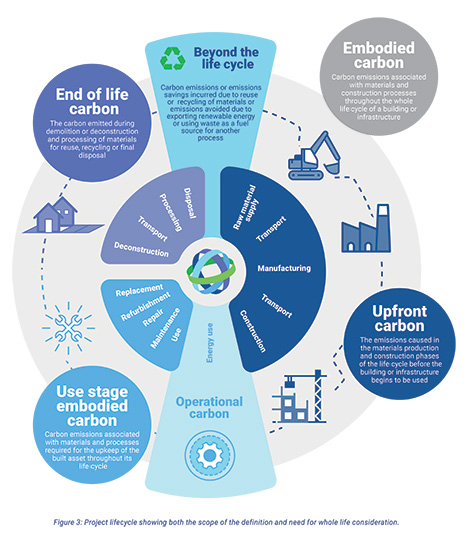

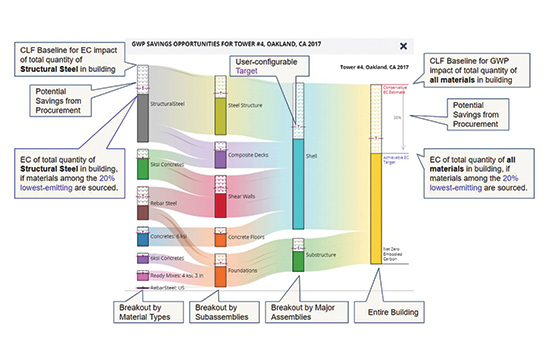


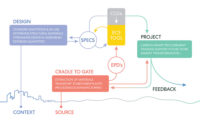
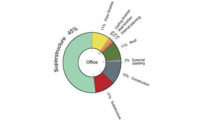

Post a comment to this article
Report Abusive Comment